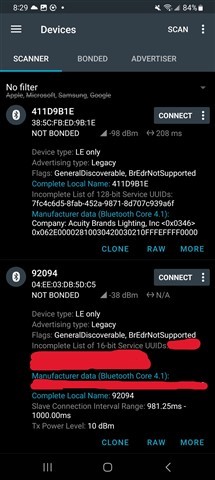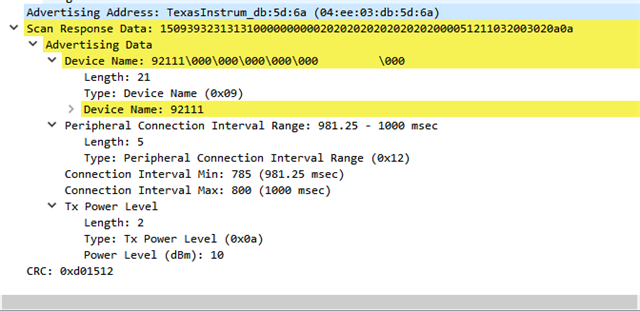I am currently developing a BLE central device to find devices based on their name to extract data from their advertising packet without connecting. I was able to do this using the UUID, but since all of these devices will be transmitting the same UUID, I need to do it based on name. I was able to find the top device in my picture using ble_advdata_name_find, but I am unable to find the device below. I am setting the device name as such for now static char const target_device_name[] = "92094"; I have attached my ble event handler as well where this data processing is done. Any help is appreciated why one device is found but the other is not!
/**@brief Function for handling BLE events.
*
* @param[in] p_ble_evt Bluetooth stack event.
* @param[in] p_context Unused.
*/
static void ble_evt_handler(ble_evt_t const * p_ble_evt, void * p_context)
{
ret_code_t err_code;
// For readability.
ble_gap_evt_t const * p_gap_evt = &p_ble_evt->evt.gap_evt;
switch (p_ble_evt->header.evt_id)
{
// Upon connection, check which peripheral is connected, initiate DB
// discovery, update LEDs status, and resume scanning, if necessary.
case BLE_GAP_EVT_CONNECTED:
{
NRF_LOG_INFO("Connection 0x%x established, starting DB discovery.",
p_gap_evt->conn_handle);
APP_ERROR_CHECK_BOOL(p_gap_evt->conn_handle < NRF_SDH_BLE_CENTRAL_LINK_COUNT);
err_code = ble_lbs_c_handles_assign(&m_lbs_c[p_gap_evt->conn_handle],
p_gap_evt->conn_handle,
NULL);
APP_ERROR_CHECK(err_code);
err_code = ble_db_discovery_start(&m_db_disc[p_gap_evt->conn_handle],
p_gap_evt->conn_handle);
APP_ERROR_CHECK(err_code);
// Update LEDs status and check whether it is needed to look for more
// peripherals to connect to.
bsp_board_led_on(CENTRAL_CONNECTED_LED);
if (ble_conn_state_central_conn_count() == NRF_SDH_BLE_CENTRAL_LINK_COUNT)
{
bsp_board_led_off(CENTRAL_SCANNING_LED);
}
else
{
// Resume scanning.
bsp_board_led_on(CENTRAL_SCANNING_LED);
scan_start();
}
} break; // BLE_GAP_EVT_CONNECTED
// Upon disconnection, reset the connection handle of the peer that disconnected, update
// the LEDs status and start scanning again.
case BLE_GAP_EVT_DISCONNECTED:
{
NRF_LOG_INFO("LBS central link 0x%x disconnected (reason: 0x%x)",
p_gap_evt->conn_handle,
p_gap_evt->params.disconnected.reason);
if (ble_conn_state_central_conn_count() == 0)
{
err_code = app_button_disable();
APP_ERROR_CHECK(err_code);
// Turn off the LED that indicates the connection.
bsp_board_led_off(CENTRAL_CONNECTED_LED);
}
// Start scanning.
scan_start();
// Turn on the LED for indicating scanning.
bsp_board_led_on(CENTRAL_SCANNING_LED);
} break;
case BLE_GAP_EVT_TIMEOUT:
{
// Timeout for scanning is not specified, so only the connection requests can time out.
if (p_gap_evt->params.timeout.src == BLE_GAP_TIMEOUT_SRC_CONN)
{
NRF_LOG_DEBUG("Connection request timed out.");
}
} break;
case BLE_GAP_EVT_CONN_PARAM_UPDATE_REQUEST:
{
NRF_LOG_DEBUG("BLE_GAP_EVT_CONN_PARAM_UPDATE_REQUEST.");
// Accept parameters requested by peer.
err_code = sd_ble_gap_conn_param_update(p_gap_evt->conn_handle,
&p_gap_evt->params.conn_param_update_request.conn_params);
APP_ERROR_CHECK(err_code);
} break;
case BLE_GAP_EVT_PHY_UPDATE_REQUEST:
{
NRF_LOG_DEBUG("PHY update request.");
ble_gap_phys_t const phys =
{
.rx_phys = BLE_GAP_PHY_AUTO,
.tx_phys = BLE_GAP_PHY_AUTO,
};
err_code = sd_ble_gap_phy_update(p_ble_evt->evt.gap_evt.conn_handle, &phys);
APP_ERROR_CHECK(err_code);
} break;
case BLE_GATTC_EVT_TIMEOUT:
{
// Disconnect on GATT client timeout event.
NRF_LOG_DEBUG("GATT client timeout.");
err_code = sd_ble_gap_disconnect(p_ble_evt->evt.gattc_evt.conn_handle,
BLE_HCI_REMOTE_USER_TERMINATED_CONNECTION);
APP_ERROR_CHECK(err_code);
} break;
case BLE_GATTS_EVT_TIMEOUT:
{
// Disconnect on GATT server timeout event.
NRF_LOG_DEBUG("GATT server timeout.");
err_code = sd_ble_gap_disconnect(p_ble_evt->evt.gatts_evt.conn_handle,
BLE_HCI_REMOTE_USER_TERMINATED_CONNECTION);
APP_ERROR_CHECK(err_code);
} break;
/* NOTE This is where we read in scanned BLE packet. We use uuid_find to filter based on UUIDs. */
/* The ble_uuid is currently set to 0x18FF which is the LE of the Pressure Sensors Watchlist data packet */
case BLE_GAP_EVT_ADV_REPORT:
// Initialize advertisement report for parsing.
bleData = p_ble_evt->evt.gap_evt.params.adv_report.data;
bool found = false;
uint8_t * p_encoded_data = bleData.p_data;
uint16_t data_len = bleData.len;
found = ble_advdata_name_find(p_encoded_data,
data_len,
target_device_name);
//found = ble_advdata_uuid_find(p_encoded_data,
// data_len,
// &ble_uuid);
if(found)
{
// Copy the entire advertising data
memcpy(pressure_data, m_scan.scan_buffer_data, BLE_PRESSURE_ADV_DATA_BUFFER_SIZE);
process_ble_data();
}
break;
default:
// No implementation needed.
break;
}
}






